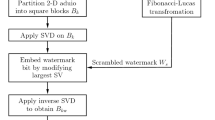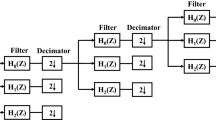Abstract
In this paper, we propose an efficient transform-based blind audio watermarking technique by introducing a parametric quantization index modulation (QIM). Theoretical expressions for the signal to watermark ratio and probability of error are derived and then used in an optimization technique based on the Lagrange multipliers method to find the optimal values for the parameters of the parametric QIM that ensure the imperceptibility while maximizing the robustness under an additive white Gaussian noise (AWGN) attack. Moreover, a fast scheme for the implementation of the proposed watermarking technique is developed and an efficient procedure is suggested to find the interval for the best selection of the watermark embedding positions that provide a good trade-off between the effects of high and low pass filtering attacks. The parameters of the resulting optimal parametric QIM coupled with the embedding positions constitute a highly robust secret key for the proposed watermarking technique. We also carry out several experiments to show the usefulness of the theoretical analysis presented in the paper and compare the proposed technique with other existing QIM-based watermarking techniques by considering known attacks such as AWGN, re-quantization, resampling, low/high pass filtering, amplitude scaling and common lossy compressions.








Similar content being viewed by others
References
Al-Haj A (2014) A dual transform audio watermarking algorithm. Multimed Tools Appl 73:1897–1912. https://doi.org/10.1007/s11042-013-1645-z
Cheddad A, Condell J, Curran K, Mc Kevitt P (2010) Digital image steganography: survey and analysis of current methods. Signal Process 90:727–752. https://doi.org/10.1016/j.sigpro.2009.08.010
Chen ST, Huang HN (2016) Optimization-based audio watermarking with integrated quantization embedding. Multimed Tools Appl 75:4735–4751. https://doi.org/10.1007/s11042-015-2500-1
Chen B, Wornell GW (1998) Digital watermarking and information embedding using dither modulation. Multimed Signal Process 1998 I.E. Second Work 273–278. https://doi.org/10.1109/MMSP.1998.738946
Chen B, Wornell GW (1999) Provably robust digital watermarking. In: Tescher AG, Vasudev B, Bove, Jr. VM, Derryberry B (eds) Proceeding SPIE Multimed. Syst. Appl. II. pp 43–54
Chen B, Wornell GW (2000) Preprocessed and postprocessed quantization index modulation methods for digital watermarking. In: Wong PW, Delp III EJ (eds) SPIE - Secur. Watermarking Multimed. Contents II. pp 48–59
Chen B, Wornell GW (2001) Quantization index modulation: a class of provably good methods for digital watermarking and information embedding. IEEE Trans Inf Theory 47:1423–1443. https://doi.org/10.1109/18.923725
Chen OTC, Wu WC (2008) Highly robust, secure, and perceptual-quality echo hiding scheme. IEEE Trans Audio Speech Lang Process 16:629–638. https://doi.org/10.1109/TASL.2007.913022
Chen S-T, Wu G-D, Huang H-N (2010) Wavelet-domain audio watermarking scheme using optimisation-based quantisation. IET Signal Process 4:720. https://doi.org/10.1049/iet-spr.2009.0187
Clerc M, Kennedy J (2002) The particle swarm-explosion, stability, and convergence in a multidimensional complex space. IEEE Trans Evol Comput 6:58–73. https://doi.org/10.1109/4235.985692
Cox IJ, Kilian J, Leighton FT, Shamoon T (1997) Secure spread spectrum watermarking for multimedia. IEEE Trans Image Process 6:1673–1687. https://doi.org/10.1109/83.650120
Eberhart RC, Shi Y (2001) Particle swarm optimization: developments, applications and resources. Proc 2001 Congr Evol Comput (IEEE Cat No01TH8546) 1:81–86. https://doi.org/10.1109/CEC.2001.934374
Hemis M, Boudraa B, Merazi-meksen T (2015) Intelligent audio watermarking algorithm using multi-objective particle swarm optimization. In: 2015 4th Int. Conf. Electr. Eng. IEEE, pp 0–4
Hu HT, Hsu LY (2015) Robust, transparent and high-capacity audio watermarking in DCT domain. Signal Process 109:226–235. https://doi.org/10.1016/j.sigpro.2014.11.011
Hua G, Huang J, Shi YQ et al (2016) Twenty years of digital audio watermarking—a comprehensive review. Signal Process 128:222–242. https://doi.org/10.1016/j.sigpro.2016.04.005
Huang H, Chen S, Hsu C (2015) Wavelet-domain audio watermarking using optimal modification on low-frequency amplitude. IET Signal Process 9:166–176. https://doi.org/10.1049/iet-spr.2013.0399
Kalantari NK, Ahadi SM (2010) A logarithmic quantization index modulation for perceptually better data hiding. IEEE Trans Image Process 19:1504–1517. https://doi.org/10.1109/TIP.2010.2042646
Lei BY, Soon IY, Li Z (2011) Blind and robust audio watermarking scheme based on SVDDCT. Signal Process 91:1973–1984. https://doi.org/10.1016/j.sigpro.2011.03.001
Li Q, Cox IJ (2007) Using perceptual models to improve fidelity and provide resistance to valumetric scaling for quantization index modulation watermarking. IEEE Trans Inf Forensics Secur 2:127–138. https://doi.org/10.1109/TIFS.2007.897266
Li Z, Sun Q, Lian Y (2006) Design and analysis of a scalable watermarking scheme for the scalable audio coder. IEEE Trans Signal Process 54:3064–3077. https://doi.org/10.1109/TSP.2006.875393
Lie WN, Chang LC (2006) Robust and high-quality time-domain audio watermarking based on low-frequency amplitude modification. IEEE Trans Multimed 8:46–59. https://doi.org/10.1109/TMM.2005.861292
Liu N, Amin P, Ambalavanan A, Subbalakshmi KP (2006) An overview of digital watermarking. In: Multimed. Secur. Technol. Digit. Rights Manag. Elsevier, pp 167–195
Marini F, Walczak B (2015) Particle swarm optimization (PSO). A tutorial. Chemom Intell Lab Syst 149:153–165. https://doi.org/10.1016/j.chemolab.2015.08.020
Puschel M (2003) Cooley-Tukey FFT like algorithms for the DCT. In: 2003 I.E. Int. Conf. Acoust. Speech, Signal Process. 2003. Proceedings. (ICASSP ‘03). IEEE, p II-501-4
Renza D, Ballesteros DM, Ortiz HD (2016) Text hiding in images based on QIM and OVSF. IEEE Lat Am Trans 14:1206–1212. https://doi.org/10.1109/TLA.2016.7459600
Tim J, Juergen S (2005) Digital watermarking and its impact on intellectual property limitation for the digital age. J Electron Commer Organ 3:72–82. https://doi.org/10.4018/jeco.2005010105
Wah B, Wang T (1999) Efficient and adaptive lagrange-multiplier optimization. J Glob Optim:1–25. https://doi.org/10.1023/A.1008203422124
Wang YG, Zhu G (2015) An improved AQIM watermarking method with minimum-distortion angle quantization and amplitude projection strategy. Inf Sci (Ny) 316:40–53. https://doi.org/10.1016/j.ins.2015.04.029
Wu S, Huang J, Huang D, Shi YQ (2005) Efficiently self-synchronized audio watermarking for assured audio data transmission. IEEE Trans Broadcast 51:69–76. https://doi.org/10.1109/TBC.2004.838265
Xiang S, Kim HJ, Huang J (2008) Audio watermarking robust against time-scale modification and MP3 compression. Signal Process 88:2372–2387. https://doi.org/10.1016/j.sigpro.2008.03.019
Xiang Y, Peng D, Natgunanathan I, Zhou W (2011) Effective pseudonoise sequence and decoding function for imperceptibility and robustness enhancement in time-spread echo-based audio watermarking. IEEE Trans Multimed 13:2–13. https://doi.org/10.1109/TMM.2010.2080668
Xiang Y, Natgunanathan I, Peng D et al (2012) A dual-channel time-spread echo method for audio watermarking. IEEE Trans Inf Forensics Secur 7:383–392. https://doi.org/10.1109/TIFS.2011.2173678
Yubao Bai Y, Sen Bai S, Guibin Zhu G, et al (2010) A blind audio watermarking algorithm based on FFT coefficients quantization. In: 2010 Int. Conf. Artif. Intell. Educ. IEEE, pp 529–533
Zareian M, Tohidypour HR (2013) Robust quantisation index modulation-based approach for image watermarking. Image Process IET 7:432–441. https://doi.org/10.1049/iet-ipr.2013.0048
Author information
Authors and Affiliations
Corresponding author
Rights and permissions
About this article
Cite this article
Terchi, Y., Bouguezel, S. A blind audio watermarking technique based on a parametric quantization index modulation. Multimed Tools Appl 77, 25681–25708 (2018). https://doi.org/10.1007/s11042-018-5813-z
Received:
Revised:
Accepted:
Published:
Issue Date:
DOI: https://doi.org/10.1007/s11042-018-5813-z




